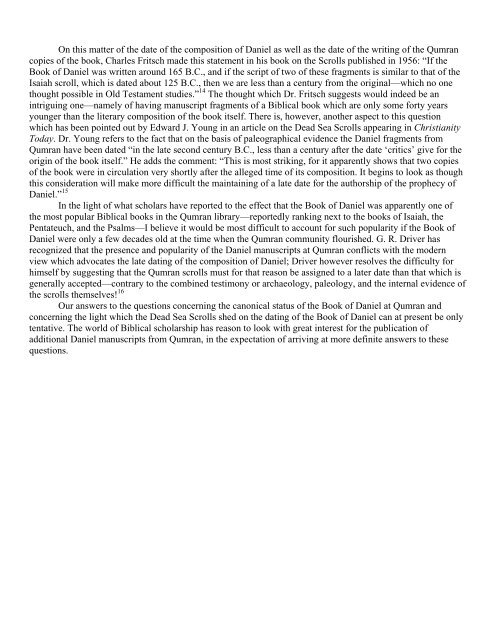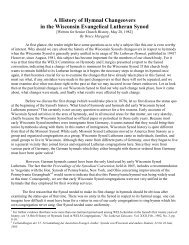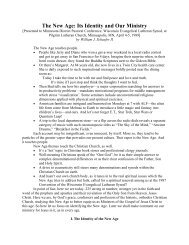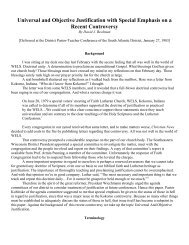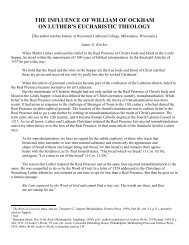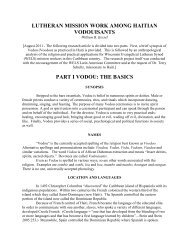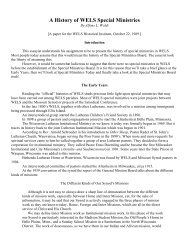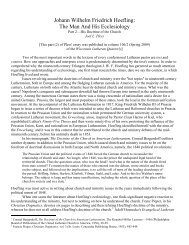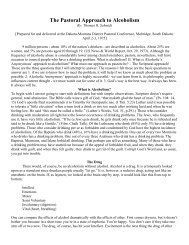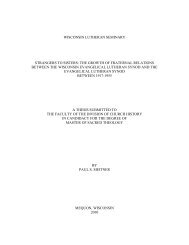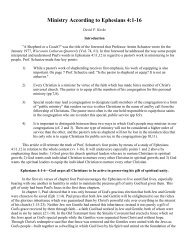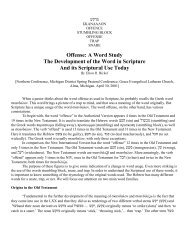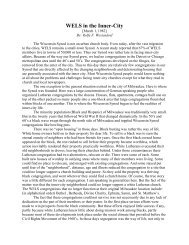The Book Of Daniel And The Dead Sea Scrolls - Wisconsin Lutheran ...
The Book Of Daniel And The Dead Sea Scrolls - Wisconsin Lutheran ...
The Book Of Daniel And The Dead Sea Scrolls - Wisconsin Lutheran ...
Create successful ePaper yourself
Turn your PDF publications into a flip-book with our unique Google optimized e-Paper software.
On this matter of the date of the composition of <strong>Daniel</strong> as well as the date of the writing of the Qumran<br />
copies of the book, Charles Fritsch made this statement in his book on the <strong>Scrolls</strong> published in 1956: “If the<br />
<strong>Book</strong> of <strong>Daniel</strong> was written around 165 B.C., and if the script of two of these fragments is similar to that of the<br />
Isaiah scroll, which is dated about 125 B.C., then we are less than a century from the original—which no one<br />
thought possible in Old Testament studies.” 14 <strong>The</strong> thought which Dr. Fritsch suggests would indeed be an<br />
intriguing one—namely of having manuscript fragments of a Biblical book which are only some forty years<br />
younger than the literary composition of the book itself. <strong>The</strong>re is, however, another aspect to this question<br />
which has been pointed out by Edward J. Young in an article on the <strong>Dead</strong> <strong>Sea</strong> <strong>Scrolls</strong> appearing in Christianity<br />
Today. Dr. Young refers to the fact that on the basis of paleographical evidence the <strong>Daniel</strong> fragments from<br />
Qumran have been dated “in the late second century B.C., less than a century after the date ‘critics’ give for the<br />
origin of the book itself.” He adds the comment: “This is most striking, for it apparently shows that two copies<br />
of the book were in circulation very shortly after the alleged time of its composition. It begins to look as though<br />
this consideration will make more difficult the maintaining of a late date for the authorship of the prophecy of<br />
<strong>Daniel</strong>.” 15<br />
In the light of what scholars have reported to the effect that the <strong>Book</strong> of <strong>Daniel</strong> was apparently one of<br />
the most popular Biblical books in the Qumran library—reportedly ranking next to the books of Isaiah, the<br />
Pentateuch, and the Psalms—I believe it would be most difficult to account for such popularity if the <strong>Book</strong> of<br />
<strong>Daniel</strong> were only a few decades old at the time when the Qumran community flourished. G. R. Driver has<br />
recognized that the presence and popularity of the <strong>Daniel</strong> manuscripts at Qumran conflicts with the modern<br />
view which advocates the late dating of the composition of <strong>Daniel</strong>; Driver however resolves the difficulty for<br />
himself by suggesting that the Qumran scrolls must for that reason be assigned to a later date than that which is<br />
generally accepted—contrary to the combined testimony or archaeology, paleology, and the internal evidence of<br />
the scrolls themselves! 16<br />
Our answers to the questions concerning the canonical status of the <strong>Book</strong> of <strong>Daniel</strong> at Qumran and<br />
concerning the light which the <strong>Dead</strong> <strong>Sea</strong> <strong>Scrolls</strong> shed on the dating of the <strong>Book</strong> of <strong>Daniel</strong> can at present be only<br />
tentative. <strong>The</strong> world of Biblical scholarship has reason to look with great interest for the publication of<br />
additional <strong>Daniel</strong> manuscripts from Qumran, in the expectation of arriving at more definite answers to these<br />
questions.


